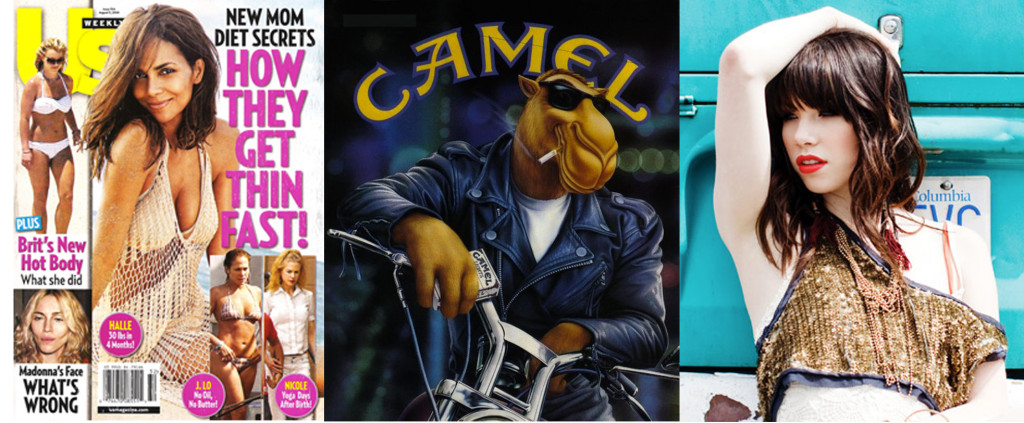BIG QUESTION: What is media literacy? How do mass media, advertising, image-manipulation and corporate bias play a role in our daily lives?
UNIT/LESSON TITLE: Under Pressure (Lesson 3: Who Puts the “Me” in “Media?”)
GRADE LEVEL: 9-12
SUGGESTED TIME ALLOWANCE: One two-hour class session
CENTRAL FOCUS/OVERVIEW: This lesson will introduce students to the concept of media literacy, and open their eyes to concepts such as brand recognition/corporate bias, the psychological/emotional impact of advertising (and video/image manipulation), and the various day-to-day pressures of living in a consumptive culture. Through looking at images/video/art exemplifying pop/media culture and creating their own artworks appealing to our consumerist nature, students will explore the relationship of media and power, start to question the source and impact of information (who disseminates information? why? what story are they trying to tell?) and think critically about the interplay between mainstream media and society.
ESSENTIAL QUESTIONS: How much are we influenced by media/advertising? Can we be influenced without even realizing it? How does what we read, or see on tv/movies affect us/shape our societal norms? Does being aware of these pressures/influences make us less susceptible? What is the relationship between pressure and authority? Who has that power and why do they want it? Where do we see power in the media?
LEARNING OBJECTIVES:
MATERIALS/EQUIPMENT: Projector or tv screen for displaying images; whiteboard, dry-erase markers; Flashcards (with logos, slogans, corporate mascots); posterboard (or large pieces of construction paper); scissors, drawing materials (markers, colored pencils, pencils, charcoal), glue sticks, magazines, letter stencils, product descriptions for art activity.
ARTISTS: Hiroshi Fuji, Barbara Kruger, Lega Delany.
 From left: Hiroshi Fuji, Toy Saurus; Barbara Kruger, I Shop Therefore I am (Exhibition at L&M Arts); Lega Delany, Plant for the Planet
From left: Hiroshi Fuji, Toy Saurus; Barbara Kruger, I Shop Therefore I am (Exhibition at L&M Arts); Lega Delany, Plant for the Planet
PROCEDURE:
I. INTRO ACTIVITY: Logos/Slogans/Brand Recognition Game (from Media Literacy reading): Reference last week’s lesson (eg “Last time we talked about personal pressure, and we’ve experienced it firsthand through our Chopped game and the making of our Pressure Portraits. Today we’re going to talk about media pressure”), then immediately jump into the game. We will run through a series of slides showing a variety of slogans, logos, and brand mascots as students try to recognize and shout out the name of the company, brand or product associated with each slide as quickly as possibly.
II. POST-ACTIVITY DISCUSSION:
III. MEDIA PRESENTATION/DISCUSSION: A rapid-fire presentation on media influences — covering pop culture, consumerism, technology, fast food/obesity, politics/presidential campaign, standards of beauty — which should turn into a larger discussion. (Does media pressure exist in our society, & how does it affect us? What is the relationship between pressure and authority? Who has that power and why do they want it? Does being aware of media pressures/influences — consumerism, corporate bias, etc — make us less susceptible?)
IV. ARTIST PRESENTATION
V. ART ACTIVITY (“Marketing 101”): Break the students up into small groups, handing each one a description of a new product to market (14 year-old pop star, new energy drink, political candidate, etc) and ask them to create a poster introducing their product to the public. (Questions to consider: Who is your target demographic? What is the most effective way to brand your product while appealing to a wide audience? What aspects will you choose to accentuate/underplay? Are these “truthful” depictions? Are they effective?)
**The idea here isn’t to create new, more positive ads (ie the media literacy reading) or super negative ads (like Rob’s chocolate bars), but merely to get the kids thinking about what kinds of products are marketed towards THEM on a daily basis, and by what means.
 Student work: Advertising 101 (Visionary Studios)
Student work: Advertising 101 (Visionary Studios)
VI. PRESENTATION OF WORK/DISCUSSION: What were the students thinking about when they created their posters? Did they succeed in marketing their products? What products are being marketed to us on a daily basis? Where would you choose to display your ad/in what format, in order to reach your target market?
*Students will pitch their ad campaign to the rest of the class; after each presentation the rest of the class will quickly vote by a show of hands whether they think the ad is successful or not in reaching/persuading its target demographic.
CLEANUP/CONCLUSION:
OPTIONAL MEDIA LITERACY HANDOUT (for anyone interested in exploring this topic for the exhibition):
 Examples of media/advertising/celebrity.
Examples of media/advertising/celebrity.
ASSESSMENT OF STUDENT WORK:
VISUAL ARTS STANDARDS:
Standard 1:
Standard 3:
Standard 4: